Lifelong Learning A Continuous Journey
Embarking on a journey of lifelong learning signifies a commitment to continuous growth and adaptation. It transcends the traditional confines of formal education, encompassing a diverse range of experiences and methodologies aimed at personal and professional enrichment. This exploration delves into the multifaceted nature of lifelong learning, examining its benefits, challenges, and future implications in a rapidly evolving world.
From childhood curiosity to the wisdom of later years, the pursuit of knowledge remains a constant. We will investigate how lifelong learning fosters resilience, adaptability, and a deeper understanding of ourselves and the world around us, impacting not only individual lives but also the collective progress of society.
Defining Lifelong Learning
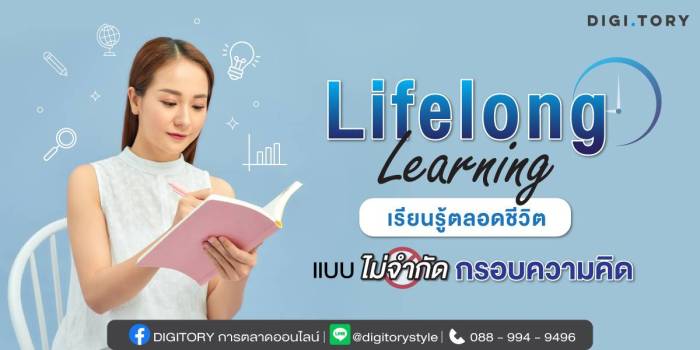
Lifelong learning is the continuous pursuit of knowledge and skills throughout one’s life, extending far beyond formal education. It’s a proactive and self-directed process of personal and professional development, encompassing various learning styles and methods, driven by intrinsic motivation and a desire for personal and societal growth.
Lifelong learning encompasses formal education, such as university courses or professional certifications, but also extends to informal learning opportunities like online courses, workshops, mentoring, reading, and even self-reflection. It’s characterized by adaptability, a willingness to embrace new challenges, and a commitment to continuous improvement.
Motivations Behind Pursuing Lifelong Learning
Individuals engage in lifelong learning for a multitude of reasons. These motivations are often intertwined and can shift over time. Key drivers include the desire for career advancement, enhanced employability in a rapidly changing job market, personal enrichment and intellectual stimulation, improved quality of life, and a greater sense of purpose and fulfillment. For example, someone might pursue a coding bootcamp to transition to a higher-paying tech role, while another might take up painting classes for personal fulfillment and stress reduction. The common thread is a proactive approach to personal and professional development.
Comparison of Lifelong Learning and Traditional Education Models
Traditional education models, while crucial for foundational knowledge, are often structured and time-limited. They typically focus on structured curricula and assessments within a defined timeframe, often culminating in a degree or certificate. Lifelong learning, on the other hand, is far more flexible and adaptable. It is self-directed, often asynchronous, and can incorporate a wider range of learning methodologies tailored to individual needs and preferences. While traditional education provides a strong base, lifelong learning builds upon this foundation, allowing individuals to specialize, adapt to new technologies, and continually upgrade their skills throughout their careers and lives. A key difference is the inherent focus on self-directed learning and personal growth within lifelong learning, compared to the often externally driven structure of traditional education.
Benefits of Lifelong Learning
The benefits of lifelong learning are significant for both individuals and society.
| Benefit | Individual Impact | Societal Impact | Example |
|---|---|---|---|
| Increased Employability | Improved job prospects, higher earning potential, greater career flexibility | Stronger economy, reduced unemployment, increased innovation | A nurse completing continuing education courses to maintain licensure and stay current with medical advancements. |
| Enhanced Adaptability | Ability to navigate career transitions, adapt to technological changes, and embrace new challenges | Increased workforce agility, faster technological adoption, greater resilience to economic shifts | A graphic designer learning new software to meet evolving industry standards. |
| Improved Cognitive Function | Improved memory, problem-solving skills, and critical thinking abilities | Increased productivity, enhanced innovation, better informed citizenry | An individual learning a new language to improve cognitive function and enhance travel experiences. |
| Greater Personal Fulfillment | Increased self-confidence, sense of accomplishment, improved well-being | More engaged and active citizenry, stronger communities, reduced social isolation | A retiree taking up pottery classes to pursue a lifelong passion and connect with a community. |
Methods and Approaches to Lifelong Learning

Lifelong learning encompasses a diverse range of methods and approaches, catering to various learning styles and preferences. Successful lifelong learning often involves a blended approach, incorporating formal, informal, and non-formal educational avenues to maximize knowledge acquisition and skill development. The strategic selection of learning methods and the effective integration of technology play crucial roles in achieving personal and professional growth throughout life.
Diverse Lifelong Learning Methods
Lifelong learning isn’t confined to traditional classrooms. It embraces a spectrum of approaches, each offering unique benefits. Formal learning involves structured programs with accredited qualifications, such as university degrees or vocational training certificates. Informal learning, on the other hand, is unstructured and often self-directed, encompassing activities like reading books, attending workshops, or engaging in online courses. Non-formal learning falls somewhere in between, including apprenticeships, mentoring programs, and community-based learning initiatives. For example, a person might pursue a Master’s degree (formal), learn a new language through an app (informal), and volunteer at a local museum gaining practical skills (non-formal), all contributing to their lifelong learning journey.
The Role of Technology in Facilitating Lifelong Learning
Technology has revolutionized access to learning resources. Online courses (MOOCs), educational apps, virtual reality simulations, and digital libraries provide unparalleled opportunities for self-paced learning, anytime and anywhere. Social media platforms and online communities foster collaborative learning and knowledge sharing. For instance, platforms like Coursera and edX offer a vast array of courses from top universities worldwide, while language learning apps like Duolingo provide interactive and engaging learning experiences. The accessibility and flexibility offered by technology significantly broaden the scope of lifelong learning.
Advantages and Disadvantages of Different Learning Styles
Different individuals thrive with different learning styles. Visual learners benefit from diagrams, videos, and presentations, while auditory learners prefer lectures, podcasts, and discussions. Kinesthetic learners learn best through hands-on activities and practical experience. While technology can cater to diverse learning styles, its overuse can lead to distractions and information overload. For example, visual learners might struggle with purely auditory learning materials, and kinesthetic learners may find online lectures less engaging than practical workshops. Understanding one’s preferred learning style and adapting learning methods accordingly is crucial for effective lifelong learning.
Resources for Lifelong Learning
Individuals seeking lifelong learning opportunities have access to a wealth of resources:
- Online Learning Platforms: Coursera, edX, Udemy, FutureLearn, Khan Academy
- Universities and Colleges: Offer continuing education programs and online courses.
- Professional Organizations: Provide workshops, conferences, and certifications relevant to specific fields.
- Libraries and Museums: Offer educational resources, workshops, and lectures.
- Community Colleges: Provide affordable access to a variety of courses and programs.
- Mentorship Programs: Offer guidance and support from experienced professionals.
- Online Communities and Forums: Facilitate knowledge sharing and peer learning.
Lifelong Learning in Different Life Stages
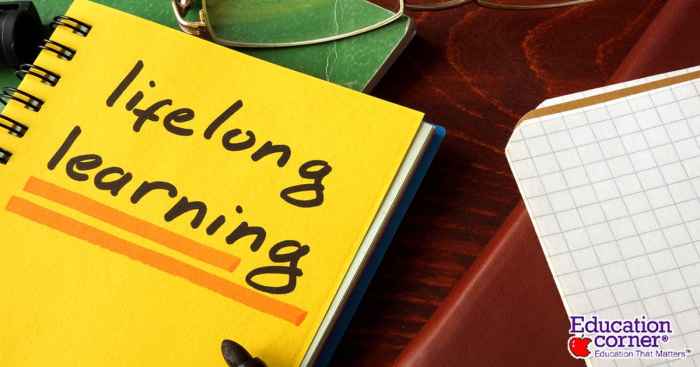
Lifelong learning is not a monolithic concept; its relevance and application vary significantly across different life stages. Understanding these variations is crucial for tailoring learning experiences to maximize individual potential and address specific needs at each juncture. This section will explore the unique learning needs and opportunities presented during childhood, adolescence, adulthood, and retirement, highlighting how lifelong learning supports career transitions and professional development while acknowledging the diverse challenges encountered across age groups.
Learning Needs and Opportunities Across Life Stages
The learning journey is a continuous process, adapting to the changing demands and opportunities presented at each life stage. Childhood focuses on foundational knowledge and skill development, laying the groundwork for future learning. Adolescence involves navigating identity formation and exploring career paths, requiring adaptable learning strategies. Adulthood often centers around professional development, personal growth, and family responsibilities, demanding efficient and flexible learning approaches. Finally, retirement presents an opportunity for pursuing personal interests and contributing to society through new learning ventures.
Lifelong Learning and Career Transitions
Lifelong learning plays a pivotal role in navigating career transitions at all life stages. During childhood, exposure to diverse learning experiences helps children develop a broad range of skills, increasing their adaptability later in life. In adolescence, exploring various subjects and vocational training can aid in career exploration and informed decision-making. For adults, continuous professional development is essential for career advancement, adapting to technological changes, and managing career transitions. In retirement, lifelong learning can facilitate second careers, volunteering opportunities, or simply maintaining cognitive function and engaging in stimulating activities.
Challenges in Pursuing Lifelong Learning Across Age Groups
While the benefits of lifelong learning are undeniable, various challenges exist across different age groups. Children might face limited access to quality learning resources or lack the motivation to engage in self-directed learning. Adolescents may struggle with balancing academic demands with social and extracurricular activities. Adults often juggle work, family, and other commitments, limiting their time and energy for learning. Finally, retirees may encounter barriers such as financial constraints, technological limitations, or a lack of social support networks that encourage learning.
Visual Representation of Evolving Learning Needs
Imagine a tree representing a person’s life. The roots represent foundational learning in childhood, characterized by broad, basic skills like reading, writing, and arithmetic. The trunk symbolizes adolescent learning, focusing on specialized knowledge and skill development, branching out into various academic and vocational paths. The branches represent adult learning, showcasing diverse career paths and personal interests, with new branches constantly emerging to reflect changing circumstances and opportunities. Finally, the leaves represent retirement learning, showcasing a broader, less focused range of interests, enriching life with new experiences and personal fulfillment. The tree’s growth illustrates the dynamic and continuous nature of learning throughout life, adapting to changing needs and opportunities at each stage.
The Impact of Lifelong Learning on Personal and Professional Growth
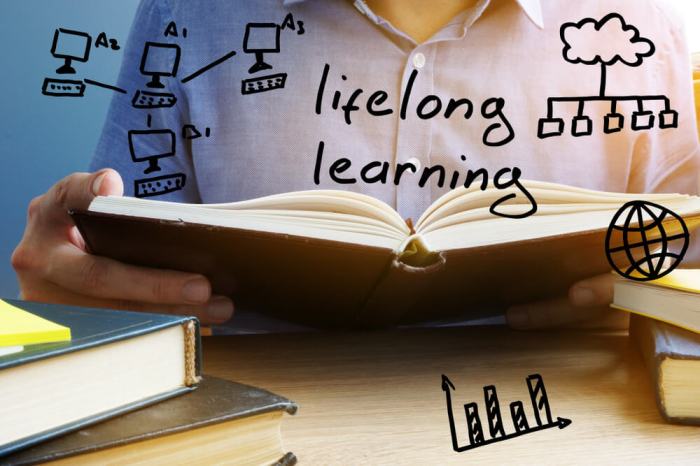
Lifelong learning profoundly impacts both personal and professional spheres, fostering continuous development and enrichment. It’s not merely about accumulating knowledge; it’s about cultivating adaptability, critical thinking, and a growth mindset – qualities increasingly valued in today’s dynamic world. The benefits extend far beyond the acquisition of specific skills, enriching personal lives and enhancing career prospects.
Lifelong learning enhances personal skills and knowledge by providing opportunities to explore diverse subjects, develop new hobbies, and improve existing abilities. This continuous learning process cultivates a more well-rounded individual, capable of adapting to change and engaging more fully with the world. The acquisition of new knowledge boosts confidence, expands perspectives, and encourages intellectual curiosity, leading to a more fulfilling and engaging life.
Enhanced Employability and Career Advancement
Lifelong learning directly contributes to increased employability and career advancement. In today’s competitive job market, individuals with a demonstrated commitment to continuous learning are highly sought after. Employers value employees who proactively update their skills and knowledge, ensuring they remain relevant and productive. This commitment can manifest in various ways, such as pursuing professional certifications, attending workshops, or engaging in online courses. These efforts not only improve job performance but also demonstrate initiative and a dedication to professional growth, leading to greater opportunities for promotion and increased earning potential. For example, an accountant pursuing a data analytics certification significantly enhances their marketability and opens doors to higher-paying roles in the burgeoning field of financial technology.
Personal Fulfillment and Well-being
The pursuit of lifelong learning is intrinsically linked to personal fulfillment and well-being. The process of learning itself can be deeply rewarding, fostering a sense of accomplishment and boosting self-esteem. Engaging in activities that stimulate the mind and challenge one’s abilities can combat feelings of stagnation and contribute to a greater sense of purpose. Moreover, lifelong learning often leads to the development of new social connections through participation in classes, workshops, or online communities, fostering a sense of belonging and reducing feelings of isolation. This holistic approach to personal growth significantly impacts mental and emotional well-being.
Examples of Individuals Benefitting from Lifelong Learning
Consider the case of Sarah, a registered nurse who, after years of experience, decided to pursue a master’s degree in nursing administration. This decision not only enhanced her clinical expertise but also opened up leadership opportunities within her hospital, ultimately leading to a promotion and increased job satisfaction. Another example is Mark, a mid-level manager who recognized the importance of digital marketing in his industry. He enrolled in online courses and workshops, mastering new skills that significantly improved his team’s performance and secured him a promotion to a more senior role. These examples highlight how lifelong learning can serve as a catalyst for both personal and professional transformation.
Challenges and Barriers to Lifelong Learning
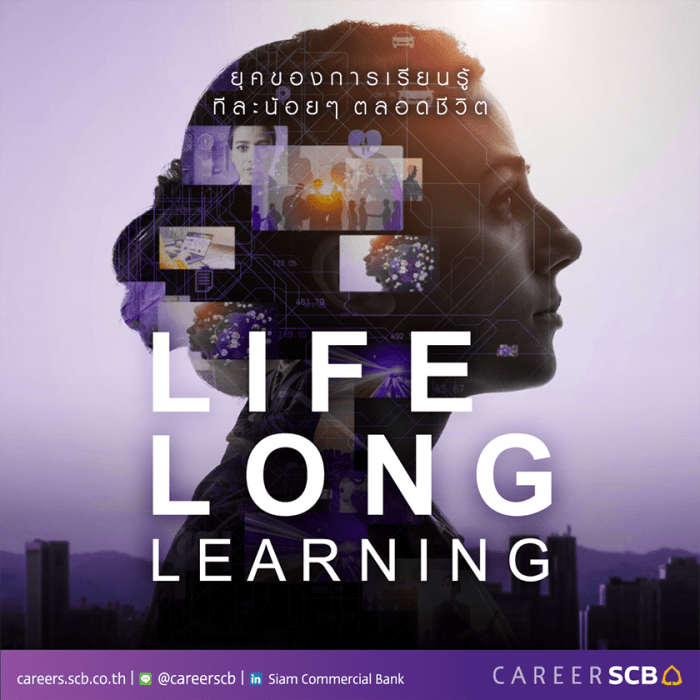
Lifelong learning, while beneficial, faces numerous obstacles that prevent widespread participation. These hurdles are multifaceted, encompassing individual circumstances, societal structures, and systemic issues. Understanding these barriers is crucial to developing effective strategies for promoting accessible and inclusive lifelong learning opportunities for all.
Numerous factors contribute to the difficulties individuals encounter when attempting to pursue lifelong learning. These obstacles are not insurmountable, but require proactive and multifaceted solutions.
Financial Constraints and Resource Accessibility
Financial limitations represent a significant barrier to lifelong learning. Tuition fees, course materials, and even the cost of transportation can be prohibitive for many individuals, particularly those from low-income backgrounds. Access to technology, including computers and reliable internet access, is also crucial for online learning, yet remains unevenly distributed across different socioeconomic groups. This digital divide further exacerbates existing inequalities in educational opportunities. For example, a single parent working multiple minimum wage jobs might find it impossible to afford evening classes or online courses, even if they are highly motivated to learn new skills. Similarly, individuals living in rural areas with limited internet access face significant challenges in participating in online learning programs.
Time Constraints and Family Responsibilities
Balancing work, family responsibilities, and personal commitments often makes it difficult for individuals to dedicate the necessary time to engage in lifelong learning activities. Many adults juggle multiple roles, making it challenging to find time for studying, attending classes, or completing online coursework. This is particularly true for parents of young children or individuals caring for elderly relatives. For instance, a working parent might struggle to find time for evening classes after a long workday and childcare responsibilities. Flexible learning options, such as online courses and self-paced programs, can help alleviate some of these time constraints, but they are not always accessible or affordable.
Lack of Motivation and Confidence
Some individuals may lack the motivation or confidence to engage in lifelong learning. Fear of failure, lack of self-efficacy, and negative past experiences with education can all contribute to feelings of apprehension and discourage participation. Furthermore, a lack of awareness about available learning opportunities or a perceived irrelevance of certain learning pathways can also lead to disengagement. For example, an individual who had negative experiences in formal education might be hesitant to return to a learning environment, even if they recognize the benefits of acquiring new skills. Building confidence and fostering a positive learning environment are essential to overcome these psychological barriers.
Strategies to Overcome Barriers and Promote Accessibility
To overcome these challenges and promote lifelong learning accessibility, a multi-pronged approach is necessary. This involves both individual strategies and systemic changes.
A structured approach to addressing individual and systemic challenges requires a coordinated effort from various stakeholders, including educational institutions, government agencies, employers, and communities.
- Increased Financial Support: Governments and educational institutions can provide financial aid, scholarships, and grants to make lifelong learning more accessible to low-income individuals. This could include tuition waivers, subsidized course materials, and transportation assistance.
- Flexible Learning Options: Offering flexible learning formats, such as online courses, blended learning programs, and self-paced modules, can cater to the diverse needs and schedules of learners.
- Improved Access to Technology: Investing in infrastructure to expand internet access and providing affordable devices to low-income individuals can bridge the digital divide and ensure equal access to online learning resources.
- Mentorship and Support Programs: Providing mentorship and support services can help learners build confidence, overcome challenges, and stay motivated throughout their learning journey.
- Employer Incentives: Employers can offer incentives, such as paid time off for training and professional development opportunities, to encourage their employees to engage in lifelong learning.
- Community-Based Initiatives: Community organizations and libraries can play a vital role in providing access to learning resources, offering workshops, and creating supportive learning environments.
The Future of Lifelong Learning
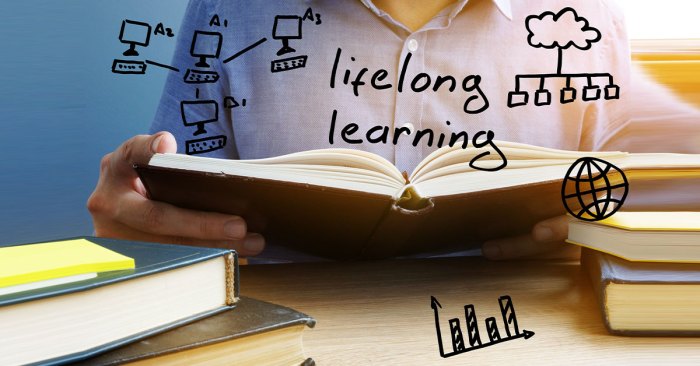
The landscape of lifelong learning is poised for a dramatic transformation, driven by rapid technological advancements and evolving societal needs. The future will see a shift from traditional, institution-centric models to more personalized, accessible, and technology-integrated approaches. This evolution will be crucial in equipping individuals with the skills and knowledge necessary to navigate an increasingly complex and rapidly changing world.
Technological Advancements and Societal Shifts Shaping Lifelong Learning
Technological advancements, such as artificial intelligence (AI), virtual and augmented reality (VR/AR), and big data analytics, are reshaping how we learn. Societal shifts, including the increasing demand for specialized skills and the growing gig economy, are also influencing the need for continuous upskilling and reskilling. These factors are converging to create a future where lifelong learning is not just desirable, but essential for personal and professional success. For example, the rise of online learning platforms like Coursera and edX has already democratized access to higher education, offering a glimpse into the future of accessible learning. The increasing use of micro-learning modules caters to the shorter attention spans and busy schedules of modern learners.
The Impact of Artificial Intelligence and Automation on the Need for Lifelong Learning
Artificial intelligence and automation are rapidly transforming the job market, rendering some roles obsolete while creating new ones requiring specialized skills. This necessitates a significant increase in the demand for lifelong learning. AI-powered tools can personalize learning experiences, providing tailored recommendations and feedback based on individual learning styles and progress. However, the displacement of workers by automation highlights the critical need for reskilling and upskilling initiatives to ensure a smooth transition into new roles. For instance, the manufacturing sector is seeing a shift from manual labor to roles requiring proficiency in robotics and automation technologies. Lifelong learning programs that bridge this gap will be essential.
Innovations Transforming Lifelong Learning Methodologies and Accessibility
Several innovations hold the potential to revolutionize lifelong learning. Personalized learning platforms powered by AI can adapt to individual learning needs, providing customized content and pacing. Immersive technologies like VR and AR can create engaging and interactive learning experiences, making learning more enjoyable and effective. Gamification techniques can enhance motivation and engagement, making learning a more rewarding process. Furthermore, advancements in neurotechnology could potentially unlock new learning methods, enhancing memory and cognitive abilities. Imagine a future where virtual reality simulations allow medical students to practice complex surgeries without risk, or where AI tutors provide instant feedback and personalized guidance to students learning a new language.
A Hypothetical Scenario Illustrating the Ideal Future of Lifelong Learning
In the ideal future of lifelong learning, individuals have seamless access to personalized learning pathways tailored to their interests and career goals. AI-powered platforms curate learning resources, providing a curated selection of courses, articles, and interactive exercises. VR/AR technologies offer immersive learning experiences, allowing individuals to learn through simulations and interactive scenarios. Micro-credentials and skills-based certifications are widely recognized and valued by employers, making lifelong learning a continuous process of skill development and career advancement. This is not a utopian dream but a realistic projection given the current trajectory of technological advancement and societal needs. Imagine a world where learning is integrated into everyday life, seamlessly blending professional development with personal enrichment, allowing individuals to continuously adapt and thrive in a rapidly changing world.
Closure

In conclusion, lifelong learning is not merely an educational pursuit; it is a fundamental aspect of human flourishing. By embracing a mindset of continuous learning and adaptation, individuals can unlock their full potential, contribute meaningfully to society, and navigate the complexities of a dynamic world with greater confidence and resilience. The future of lifelong learning is bright, promising innovative approaches and unprecedented opportunities for personal and collective growth.
Helpful Answers
What is the difference between lifelong learning and formal education?
Formal education typically follows a structured curriculum within an institution, while lifelong learning encompasses a broader range of learning experiences, both formal and informal, throughout life.
How can I afford lifelong learning opportunities?
Many free or low-cost options exist, including online courses, community college programs, and library resources. Scholarships and grants may also be available.
Is lifelong learning only for career advancement?
No, lifelong learning benefits personal fulfillment and well-being as much as career goals. It enhances personal skills, expands knowledge, and fosters a sense of purpose.
How do I find lifelong learning opportunities that suit my interests?
Explore online learning platforms (Coursera, edX, etc.), local community centers, professional organizations, and libraries. Consider your interests and career goals when choosing opportunities.





